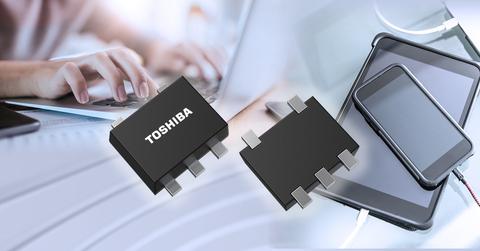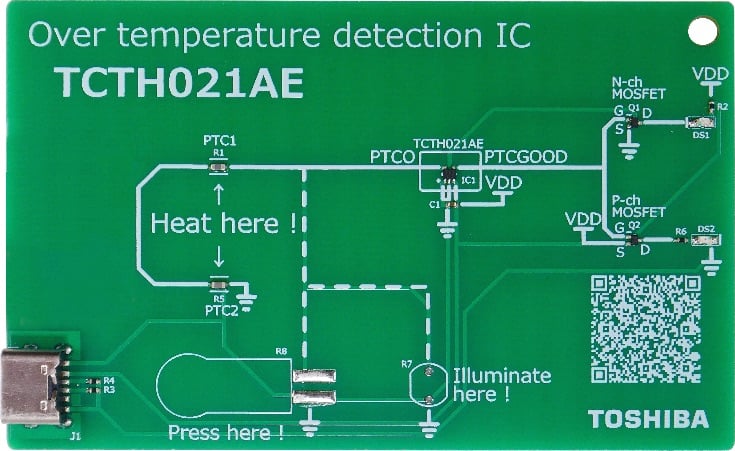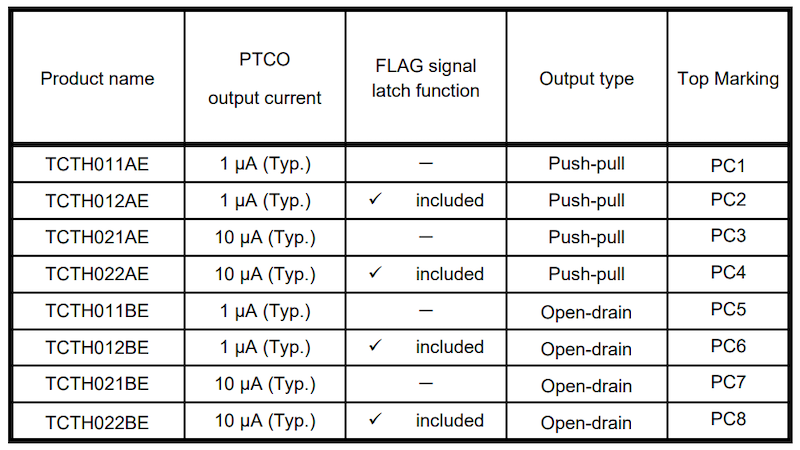Toshiba Adds Six Over-Temperature Detection ICs to Portfolio
The latest Toshiba temperature ICs extend the applicability of Thermoflagger technology.
Bolstering its line of easy-to-use monitoring ICs, Toshiba has announced six new members of its TCTH0xxE series of temperature detection circuits. As an ever-present limitation of physical systems, especially in industrial applications, heat and temperature control are both topics that electrical engineers must consider when designing high-performance equipment.

The Toshiba Thermoflagger solution offers designers an easy method for distributed temperature sensing, with its newest members extending the usability for the chips. Image used courtesy of Toshiba
Monitoring temperature is not a new technique, with temperature-dependent resistors (thermistors) being used to provide designers with an indication of heat levels. The previously released TCTH021/022BE chips made it considerably simpler for designers to measure heat, and the new members of the family continue this trend by offering engineers more options.
This article breaks down the newest members of the TCTH0xxxE family to give readers a sense of how the technology works and what benefits the new chips stand to offer designers.
Not-so-Complex Temperature Detection
The TCTH0xxxE family of temperature detection ICs leverages Toshiba’s Thermoflagger technology to measure heat levels near the board. The Thermoflagger technology allows designers to monitor multiple thermistors, giving a one-chip solution to measuring temperature across a broader range of locations.

The TCTH0x1AE highlights the simplicity of the Thermoflagger architecture, allowing designers to rapidly notify the central processor of an over-temperature event. Image used courtesy of Toshiba
While other temperature control solutions would require more design effort or calibration, Toshiba’s TCTH0xxxE series provides a turnkey solution to temperature management. The single-pin output makes it remarkably simple to monitor up to 30 thermistors to distribute the thermal sensing ability without requiring a system with 30x more complexity.
In addition, the design effort for the TCTH0xxxE series of chips has been two-fold, with Toshiba developing its chips using technical data directly from Murata Manufacturing. As such, when used with Murata PTC thermistors, designers can rest assured that they are using a chip purpose-built for the job at hand.
A World of Options
The six new members of the Thermoflagger family fill critical gaps left by the original two. Previously designers were given the option of either a latched or unlatched open-drain FLAG output with a fixed 10 µA bias current. While this did allow designers to considerably simplify their temperature detection, it does leave some to be desired for niche applications.
The product table for the Thermoflagger series highlights the unique features of each chip, giving engineers much more versatility when deploying the family in their own designs. Image used courtesy of Toshiba. (Click image to enlarge)
As such, the newly released members offer both lower power and different output types to address designer concerns. Now the Thermoflagger family offers 1 (TCTH01xxE) or 10 µA (TCTH02xxE) output currents in addition to both open-drain (TCTH0xxBE) and push-pull (TCTH0xxAE)v output stages. Designers may also still choose between latched (TCTH0x2xE) and unlatched (TCTH0x1xE) FLAG outputs, removing the need for additional pull-up components.
While the new members do not employ any inherently new technology in silicon, the broader reach afforded by the increased number of options could make the Thermoflagger family more widely adopted amongst designers.
A Simple Solution
Engineers, in addition to the physical laws taught in universities, are often at the mercy of other eponymous laws (such as the all too familiar Murphy’s Law). As such, when designing a temperature detection system for industrial equipment, it could be beneficial to consider Occam’s Razor and adopt a simpler solution.

The reference design for the TCTH021AE highlights the simplicity in deploying the chip, with a minimal number of external components needed to accomplish temperature detection. Image used courtesy of Toshiba
And while the Thermoflagger family likely cannot address the design concerns for every engineer, the simplicity with which it can be deployed offers more than just performance benefits by accelerating time-to-market and reducing BOM cost.
As the chips are released, it will be exciting to see the accuracy with which the chips can measure over-temperature—both with and without Murata parts. Regardless, increasing the number of simple solutions for engineers to make use of is certainly a benefit.








